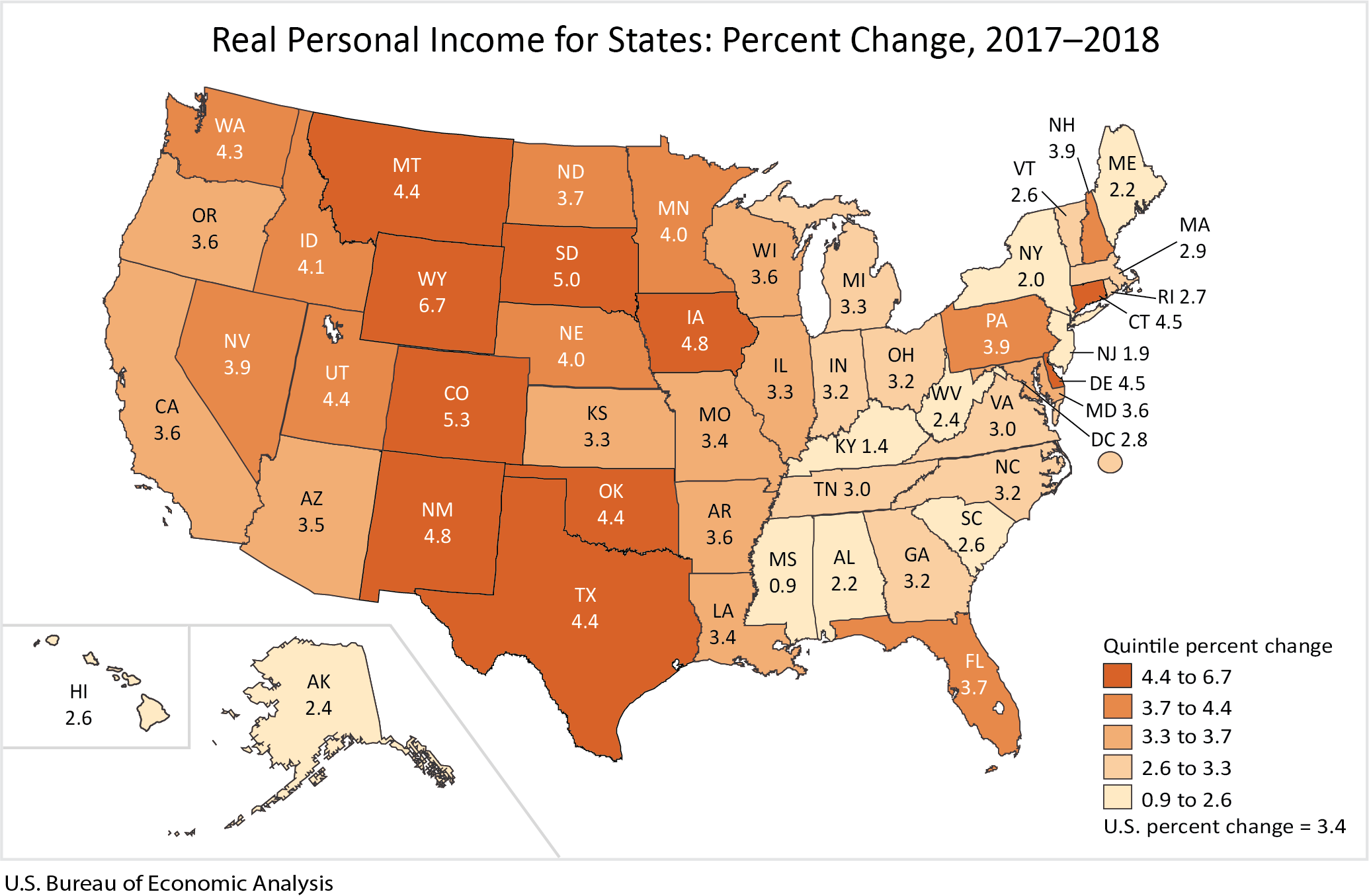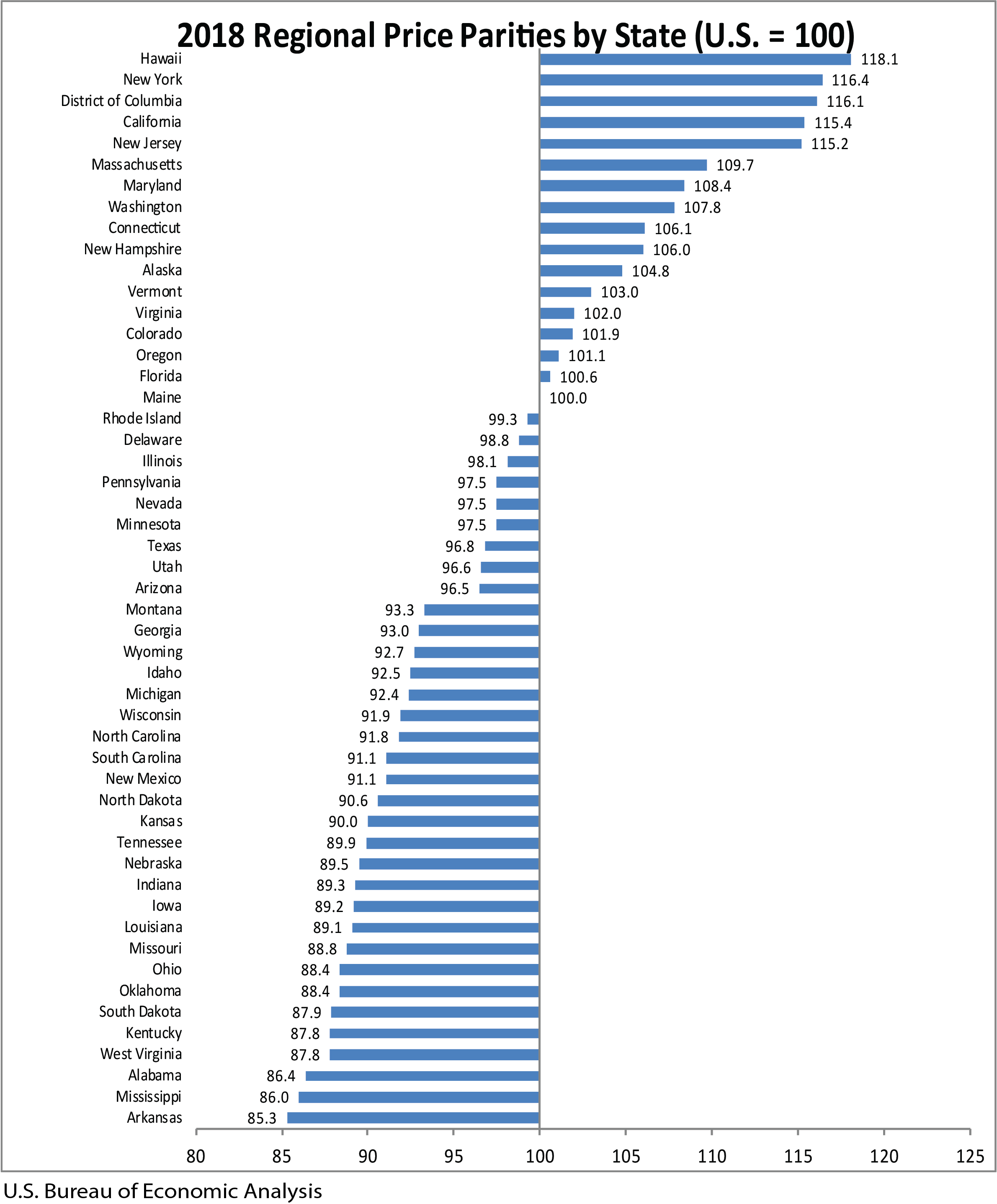News Release
Real Personal Income by State and Metropolitan Area, 2018
Real state personal income grew 3.4 percent in 2018, after increasing 2.9 percent in 2017, according to estimates released today by the Bureau of Economic Analysis. Real state personal income is a state's current-dollar personal income adjusted by the state's regional price parity and the national personal consumption expenditures price index. The percent change in real state personal income ranged from 6.7 percent in Wyoming to 0.9 percent in Mississippi (table 1). Across metropolitan areas, the percent change ranged from 15.6 percent in Midland, TX to -1.1 percent in Sebring-Avon Park, FL (table 4).

Real Personal Income in 2018
- States with the fastest growth in real personal income were Wyoming (6.7 percent), Colorado (5.3 percent), and South Dakota (5.0 percent).
- No state had a decline in real personal income. States with the slowest growth in real personal income were Mississippi (0.9 percent), Kentucky (1.4 percent), and New Jersey (1.9 percent).
- Large metropolitan areas—those with population greater than two million—with the fastest growth in real personal income were Austin-Round Rock-Georgetown, TX (6.1 percent), Denver-Aurora-Lakewood, CO (5.7 percent), and Seattle-Tacoma-Bellevue, WA (5.2 percent).
- The large metropolitan areas with the slowest growth in real personal income were Sacramento-Roseville-Folsom, CA (2.3 percent), New York-Newark-Jersey City, NY-NJ-PA (2.5 percent), and Cleveland-Elyria, OH (2.6 percent).
Regional Price Parities in 2018
Regional Price Parities (RPPs) measure the differences in price levels across states and metropolitan areas for a given year and are expressed as a percentage of the overall national price level. All items RPPs cover all consumption goods and services, including housing rents. Areas with high/low RPPs typically correspond to areas with high/low price levels for rents.
- States with the highest RPPs were Hawaii (118.1), New York (116.4), and California (115.4) (table 3). The District of Columbia's RPP was 116.1.
- States with the lowest RPPs were Arkansas (85.3), Mississippi (86.0), and Alabama (86.4).
- Across states, California had the highest RPP for housing rents (152.5) and Arkansas had the lowest (60.8).
- Large metropolitan areas with the highest RPPs were San Francisco-Oakland-Berkeley, CA (131.6), New York-Newark-Jersey City, NY-NJ-PA (124.1), and Washington-Arlington-Alexandria, DC-VA-MD-WV, (117.8) (table 6).
- Large metropolitan areas with the lowest RPPs were Cincinnati, OH-KY-IN (90.0), Cleveland-Elyria, OH (90.1), and St. Louis, MO-IL (91.0).
- Across large metropolitan areas, San Francisco-Oakland-Berkeley, CA had the highest RPP for housing rents (199.5) and Cleveland-Elyria, OH had the lowest (77.0).
- Across all metropolitan areas, San Jose-Sunnyvale-Santa Clara, CA had the highest RPP for housing rents (221.3) and Beckley, WV had the lowest (45.8).
Estimates of real personal income and regional price parities for state metropolitan and nonmetropolitan portions can be found at https://apps.bea.gov/itable/index.cfm. Supplemental tables are available upon request.

Updates to Real Personal Income
Today, BEA also released revised real personal income statistics for states and metropolitan areas for 2016-2017 and real per capita personal income statistics for states for 2010-2017. These revisions were made to incorporate newly available source data. Source data from the Consumer Price Index program incorporate geographic sample revisions. More information is available at: www.bls.gov/cpi.
BEA will update real personal income for states on September 24, 2020 with the release of state personal income. Real personal income for metropolitan areas will be updated on November 17, 2020 with the release of local area personal income.
Acceleration of Release of Real Personal Income by State and Metropolitan Area
Starting in December 2020, the release of real personal income by state and metropolitan area will accelerate by 5 months.
Next release: December 15, 2020 at 8:30 A.M. EST
Real Personal Income by State and Metropolitan Area, 2019.
* * *
Technical Notes on Regional Price Parities and Implicit Regional Price Deflators
Price indexes commonly measure price changes over time. The BEA's personal consumption expenditures (PCE) price index and the Bureau of Labor Statistics' consumer price index (CPI) are two examples. Spatial price indexes measure price level differences across regions for one time period. An example of these type of indexes are purchasing power parities (PPPs), which measure differences in price levels across countries for a given period and can be used to convert estimates of per capita GDP into comparable levels in a common currency. The regional price parities (RPPs) that BEA has developed compare regions within the United States, but without the need for currency conversion. An implicit regional price deflator (IRPD) can be derived by combining the RPPs and the U.S. PCE price index.
Regional Price Parities. The RPPs are calculated using price quotes for a wide array of items from the CPI, which are aggregated into broader expenditure categories (such as food, transportation or education)1. Data on housing rents are obtained separately from the Census Bureau's American Community Survey (ACS). The expenditure weights for each category are constructed using CPI expenditure weights, BEA's personal consumption expenditures, and ACS rents expenditures2.
The broader categories and the data on rents are combined with the expenditure weights using a multilateral aggregation method that expresses a region's price level relative to the U.S3.
For example, if the RPP for area A is 120 and for area B is 90, then on average, prices are 20 percent higher and 10 percent lower than the U.S. average for A and B, respectively. If the personal income for area A is $12,000 and for area B is $9,000, then RPP-adjusted incomes are $10,000 (or $12,000/1.20) and $10,000 (or $9,000/0.90), respectively. In other words, the purchasing power of the two incomes is equivalent when adjusted by their respective RPPs.
Implicit Regional Price Deflator. The IRPD is a regional price index derived as the product of two terms: the regional price parity and the U.S. PCE price index.
The implicit regional price deflator will equal current dollar personal income divided by real personal income in chained dollars. The growth rate or year-to-year change in the IRPDs is a measure of regional inflation4.
Detailed information on the methodology used to estimate the RPPs may be found on the regional methodology page of the BEA website: www.bea.gov/resources/methodologies.
1 The BEA Regional Price Parity statistics are based in part on restricted access Consumer Price Index data from the Bureau of Labor Statistics (BLS). The BEA statistics presented herein are products of BEA and not BLS.
2 To estimate RPPs, CPI price quotes are quality adjusted and pooled over 5 years. The ACS rents are also quality adjusted and are either annual for states or pooled over 3 years for metropolitan areas. The expenditure weights are specific for each year.
3 The multilateral system that is used is the Geary additive method. Any region or combination of regions may be used as the base or reference region without loss of consistency.
4 The growth rate of the implicit regional price deflators will not necessarily equal the region or metro area price deflators published by the BLS. This is because the CPI deflators are calculated directly while the IRPDs are indirect estimates, and because of differences in the source data and methodology.